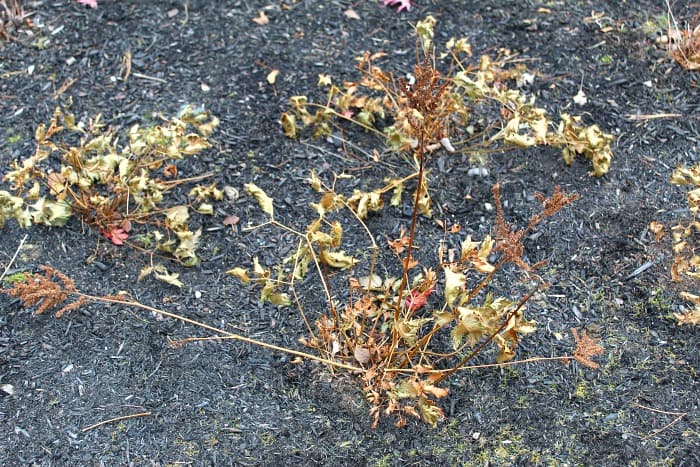Cutting back perennials is an important part of maintaining your landscape. Check out this advice on when, why, and how to cut back perennials.
For the most part it doesn’t really matter if you cut back perennials in the fall or spring. No need to scroll through the internet and look up every kind of perennial you have to see when it should be cut back.
In fact, if you did that, you’d probably realize half the answers say to cut back in fall and the other half say early spring.
Cutting back in spring, and fall, both have their advantages.
Advantages to Cutting Back Perennials In Spring
1. Less Labor- By the time the curse of winter is over, you’ll notice that the foliage from last seasons perennials will be broken down and weak. This makes them easy to cut back. Cutting back in the fall on the other hand is tougher since the foliage hasn’t had as much time to break down yet.
2. Root Protection- Leaving the dead stalks and foliage acts as natural insulation for the plants roots. This can be valuable added protection during colder winters or winters with less snow cover.
3. Birds and Wildlife- If you’re looking to help out birds and other wildlife than consider leaving perennials untouched until spring. Many perennials such as Black Eyed Susan and Coneflower offer animals a food source. Even though the flowers look completely spent they are good sources of food.
4. Some Perennials Have Winter Interest- Some perennials, like ornamental grasses for example, actually have a positive visual impact on your landscape during the winter.
Advantages to Cutting Back Perennials In Fall
1. Aesthetics- The main benefit to cutting back perennials in the fall is create a cleaner appearance. Plenty of perennials turn brown or black, and can be unsightly. If you have garden beds in main focal points of your landscape consider cutting back those perennials.
2. Fall Color- If you’re looking to ad fall color by planting mums, or asters for example, you will want to cut back perennials and do some other fall gardening chores to get the most out of these garden beds.
3. Clean up Fungus and Pests- Another reason to cut back in fall is if you suspect you had any fungal or insect problems during the past season. A lot of these problems can overwinter in the dead plant debris so it’s best to cut back and remove the infected plant material.
4. No Risk of Cutting Back New Growth– If you cut back perennials in the spring you run the risk of damaging new growth if the plant has begun to grow. That’s why you shouldn’t wait too long in the spring to cut back perennials. You don’t run this risk if you cut back perennials in the fall.
If cutting back perennials in fall, it’s best to wait until you’ve had your first frost. This is usually when perennials are checking out for the season and pruning at this time won’t harm the plant.
How to Cut Back Perennials
1. Choose the Right Tool– You have 3 choices for cutting back perennials:
The manual way: This is when you use your hands to pull off the dead debris. This works best in early spring since the plant foliage is completely dead and pulling is easy.
Pruners: Using a good pair of bypass pruners will definitely do the trick. This can be the most time consuming method but will give you the most precision.
Hedge Trimmers: This is usually the fastest way to cut back perennials. A reliable hedge trimmer is a great investment if you are looking to save time maintaining your landscape.
2. Don’t Cut Off Basal Growth– No, this doesn’t have anything to do with Basal the herb. Basal leaves are tiny little leaves that grow at the base of the plant once the rest of the plant has died back. Do your best to leave these alone, and cut dead growth up to the basal leaves, but no further.
3. Collect Debris– Collect and throw away dead debris. Do an extra good job with this step especially if you’ve had fungus or disease problems in the past. It might even be wise to remove some mulch and soil around the base of the plant and install fresh soil and mulch.
Deadheading Is Different
Don’t get confused into thinking deadheading perennials and cutting them back are the same thing. Deadheading perennials is when you remove just the spent flowers, where as cutting back perennials means your are cutting back the entire plant. Deadheading should be done after blooms have faded. Cutting back the entire plant is done much later, either fall or early the following spring.
You Man Not Need to Cut Back Evergreen Perennials
Some perennials are evergreen, meaning they don’t die back at the end of the season. They stay green all year. These perennials may not be cut back unless most of the leaves are dead or weak after the winter. Usually you just need to prune away some dead foliage in early spring or as it appears throughout the growing season. Some popular evergreen perennials are Liriope, Hellebore, Blue Fescue, Red Hot Poker, and Hardy Geraniums.
Check Out These Posts Next
Fall Gardening: Tips and Maintenance
Protecting Evergreens from Winter Burn
Follow Me
Join my free email list!



I live in Az in the desert and have shade in the summer and no shade in the winter…the result of trees losing their leaves
What can I plant in these areas?
do most herbaceous perennials die back during your winters? I know that aloes a agave are good choices for shade as well as columbine, primrose, begonias, and salvia.
LOVE this! Each year I wonder when is best to cut back my perennials. I love the idea of leaving them to protect the roots and also give the animals a little nibble to get them through the winter months. Even though it looks nice to cut them back in the Fall, I think I will leave them for Spring from now on. VERY HELPFUL article! Thanks Mark!!!
You’re very welcome Patty! Happy to hear you found this helpful! Thanks so much for leaving a comment
I live in the mountains of Oregon where we get snow and it gets pretty cold in the winter. We are still getting night time temps of 30° and below. I have left perennial flower heads for the birds for the last couple of years but I am actually uncertain as to when in the spring I should deadhead. If the birds use them in the spring to feed their young, does this mean they should stay until March, April, May? I just started to cut back some of them to clean up the garden but I’m wondering if I am too early.
Hi Debby, Personally I would go ahead and cut back now before new plant growth begins, and it will soon. As for the birds, I’m no expert but I believe once they start caring for their young in the spring they’d be more interested in early pollinators and other food sources.
We will be traveling soon and won’t return until December – will we kill our perennials if we cut them back before the first frost?
Hi Mary. Personally I’d wait until spring, that’s my preferred time to cut back, but as long as you’re in a cold enough region where your perennials are starting to check out then cutting them back before the first frost should be ok. If you’re in a warmer region though you want to make sure that the plant won’t respond by putting on new growth after cutting back.
Mark, I look forward to each of your emails. They are always informative and help me maintain a healthy, beautiful garden. Thank you for helping us grow beautiful plants.
You’re very welcome Anna, thanks so much for your support!